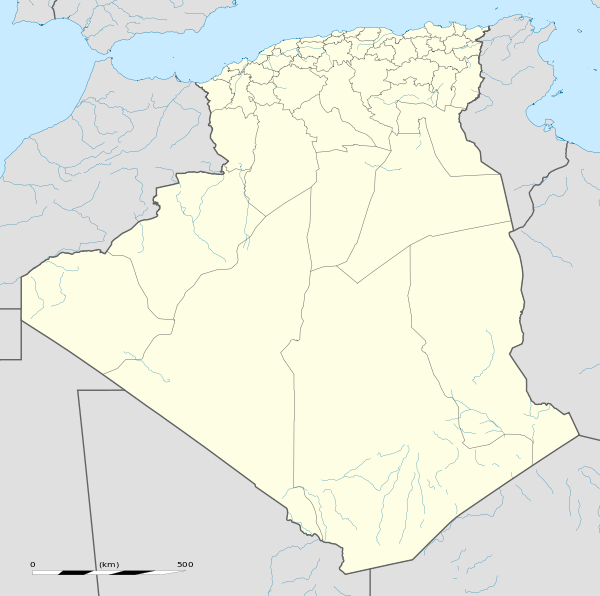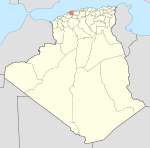Miliana
| Miliana | |
|---|---|
| Commune and town | |
|
View of Miliana | |
 | |
 Miliana | |
| Coordinates: 36°18′N 2°14′E / 36.300°N 2.233°ECoordinates: 36°18′N 2°14′E / 36.300°N 2.233°E | |
| Country |
|
| Province | Aïn Defla Province |
| Elevation | 721 m (2,365 ft) |
| Population (2008)[1] | |
| • Total | 44,201 |
| Time zone | CET (UTC+1) |
Miliana (Arabic: مليانة) is a town in Aïn Defla Province, northwestern Algeria. It is approximately 119 kilometres (74 mi) southwest of the Algerian capital, Algiers.[2] The population was estimated at 44,201 in 2008.[1] The town is located south of the Dahra Massif, on the wooded southern flank of Mount Zaccar Rherbi, five kilometers north of the Chelif River, and overlooking the Zaccar plateau to the west.[2][3]
History
Miliana corresponds[4][5] to the town of Punic origin known in Roman times as Zucchabar. Under Augustus, it was given the rank of colonia and was thus referred to as Colonia Iulia Augusta Zucchabar.[6] The Greek form of the name used by the geographer Ptolemy was Ζουχάββαρι (Zuchabbari).[7] Pliny the Elder calls it "the colony of Augusta, also called Succabar",[8] and Ammianus Marcellinus gives it the name Sugabarri or (in adjectival form) Sugabarritanum.[9][10][11]
Zucchabar belonged to the Roman province of Mauretania Caesariensis.[4][5][8] (The film Gladiator invented a Roman province of Zucchabar, which did not in fact exist.)
Zucchabar became a Christian episcopal see. The names of two of its Catholic bishops and one Donatist are recorded:[12]
- Maximianus, who attended the Conference of Carthage in 411;
- Germanus, the Donatist bishop who attended the same conference;
- Stephanus, one of the Catholic bishops whom Huneric summoned to a meeting in Carthage in February 484 and then exiled.
The bishopric is included in the Catholic Church's list of titular sees.[13]
Miliana was (re)founded in the 10th century by Buluggin ibn Ziri on the site of the ancient Roman city of Zucchabar (Succhabar).
In 1261, Miliana was conquered by Abou Hafs, bother of the the Hafsid emir of Tunis, whose forces included mercenary Christian knights led by the exile Henry of Castile.
In the 1830s, the town came under the control of Abd al-Qadir in opposition to the increasing French occupation of Algeria. In 1840, al-Qadir ordered Miliana to be burned down instead of surrendering it to the French. The town eventually fell under French control in 1842,[3] and was rebuilt in the French Colonial architectural style.[2]
Geography
Due to its position in mountainous terrain, the elevation of Miliana differs greatly, ranging from 430 metres (1,410 ft) to 870 metres (2,850 ft). Mount Zaccar Rherbi, just to the north of the city, reaches 1,550 metres (5,090 ft). There is also a smaller ridge to the south that reaches 700 metres (2,300 ft), separating Miliana from Khemis Miliana. The area around the town is well forested.
Climate
Miliana has a Mediterranean climate (Köppen climate classification Csa), with hot, dry summers and mild, wet winters.
| Climate data for Miliana | |||||||||||||
|---|---|---|---|---|---|---|---|---|---|---|---|---|---|
| Month | Jan | Feb | Mar | Apr | May | Jun | Jul | Aug | Sep | Oct | Nov | Dec | Year |
| Average high °C (°F) | 11.7 (53.1) |
12.9 (55.2) |
15.2 (59.4) |
17.4 (63.3) |
22.0 (71.6) |
27.4 (81.3) |
32.1 (89.8) |
32.2 (90) |
28.0 (82.4) |
21.9 (71.4) |
16.4 (61.5) |
12.3 (54.1) |
20.79 (69.43) |
| Daily mean °C (°F) | 8.6 (47.5) |
9.6 (49.3) |
11.3 (52.3) |
13.2 (55.8) |
17.3 (63.1) |
22.2 (72) |
26.6 (79.9) |
26.6 (79.9) |
22.9 (73.2) |
17.7 (63.9) |
12.8 (55) |
9.8 (49.6) |
16.55 (61.79) |
| Average low °C (°F) | 5.5 (41.9) |
6.2 (43.2) |
7.4 (45.3) |
9.0 (48.2) |
12.5 (54.5) |
17.0 (62.6) |
21.0 (69.8) |
21.1 (70) |
17.7 (63.9) |
13.3 (55.9) |
9.2 (48.6) |
6.2 (43.2) |
12.17 (53.93) |
| Average precipitation mm (inches) | 120.5 (4.744) |
124.0 (4.882) |
112.3 (4.421) |
71.3 (2.807) |
47.9 (1.886) |
16.8 (0.661) |
5.8 (0.228) |
7.1 (0.28) |
29.6 (1.165) |
68.9 (2.713) |
103.3 (4.067) |
119.8 (4.717) |
827.3 (32.571) |
| Source: NOAA (1969-1990)[14] | |||||||||||||
Town structure
The center of Miliana has an Muslim quarter and a French quarter, both of which are surrounded by city walls built on Turkish and Berber foundations. The main site in the Muslim quarter is the Mosque of Sidi Ahmed ben Yousef. Built in the Moorish style, the mosque is the location of a biannual pilgrimage. The Muslim quarter also contains a covered marketplace. The modern section of the town center, known as the Place Cornot (or Place de l’Horloge), is shaded by trees and contains a clock tower, formerly a minaret.[2][3]
Economy
Miliana is primarily an agricultural town. Its vineyards, orchards and gardens, which lie below the town center, are fed by water from nearby mountains that usually have snow in winters. Hydroelectricity is used to power tile factories, flour mills and other light industries.[2][3]
Recreation
The game of El Koura is a traditional game that was played in Miliana, Laghouat and other places prior to French colonization. Similar to association football,[15] the game was played during the spring and times of extreme drought because it was believed to bring rain.[16] After French colonization, European sports, especially association football, became more popular.[15]
The town is home to Algerian club football team S.C. Miliana.[17]
Notable people from Miliana
- Mustapha Ferroukhi, resistant.
- Mohamed Bouras, founder of the Algerian Muslim Scouts.
- Ali Ammar said Ali La Pointe, resistant.
- Augustin Ferrando (1880–1957), Orientalist painter, director of the School of Fine Arts in Oran.
- Marcello Fabri (1889–1945), poet and Orientalist painter, essayist, philosopher, art critic, playwright, founder of two journals.
- Sidi Ahmed Benyoucef Errachidi (1435–1524), whose mausoleum was classified a historic monument in 1978.
- Mohammed Benchicou, eminent journalist
References
- 1 2 "Algeria - largest cities". World Gazeteer. Archived from the original on 12 April 2013. Retrieved 11 February 2013.
- 1 2 3 4 5 Miliana(Algeria). Encyclopaedia Britannica Online. Retrieved October 3, 2010.
- 1 2 3 4 Miliana. LookLex Encyclopaedia. Retrieved on October 3, 2010.
- 1 2 Werner Huß "Succhabar" in Brill's New Pauly (2011)
- 1 2 Miliana ville historique
- ↑ T.W. Potter, "Zucchabar"
- ↑ Ptolemy, Book 4, chapter 2 (page 95 in the translation by Edward Luther Stevenson (New York, 1932)
- 1 2 Pliny, Natural Histories, book 5, chapter 1
- ↑ Ammianus Marcellinus, Roman History, XXIX, V, 25 and 20
- ↑ Jan den Boeft, Jan Willem Drijvers, Daniël den Hengst, Hans Teitler (editors), Philological and Historical Commentary on Ammianus Marcellinus XXIX (Brill 2013 ISBN 978-90-0426787-9), p. 179
- ↑ George Sale, George Psalmanazar, Archibald Bower, George Shelvocke, John Campbell, John Swinton An Universal History, from the Earliest Account of Time (T. Osborne 1748), p. 313
- ↑ Stefano Antonio Morcelli, Africa christiana, Volume I, Brescia 1816, p. 371]
- ↑ Annuario Pontificio 2013 (Libreria Editrice Vaticana, 2013, ISBN 978-88-209-9070-1), p. 1013
- ↑ "Climate Normals for Miliana". Retrieved 11 February 2013.
- 1 2 Sato, Daisuke. "Sport and Identity in Tunisia." International Journal of Sport and Health Science Vol 3 (2005): 27-34. Retrieved October 3, 2010.
- ↑ Hartland, E. Sidney. "Games." Encyclopedia of Religion and Ethics Part 11. Whitefish, Montana: Kessinger, 2003. 167-71.
- ↑ Algeria. Club-Soccer.com. Retrieved October 3, 2010.
